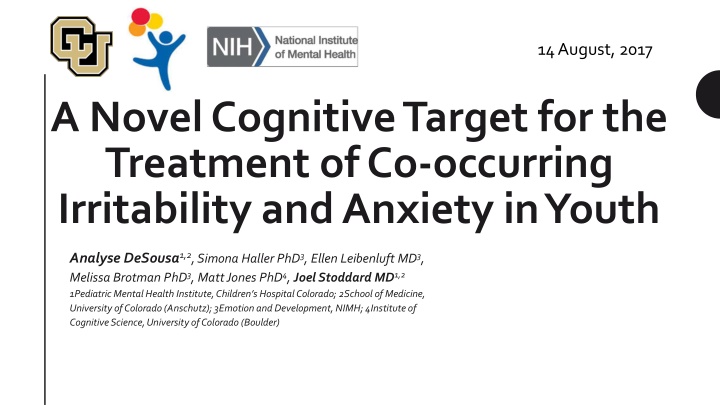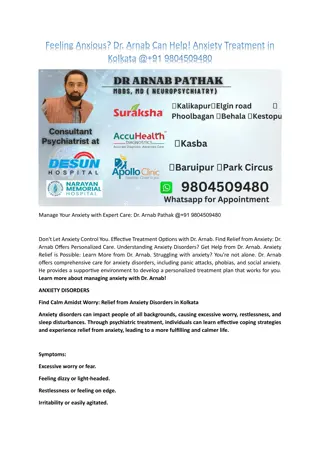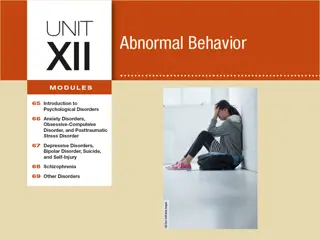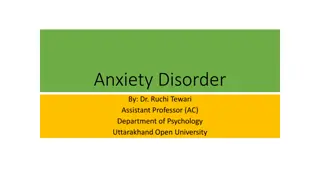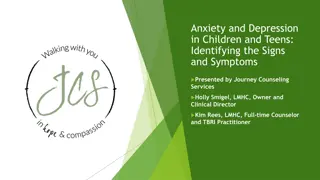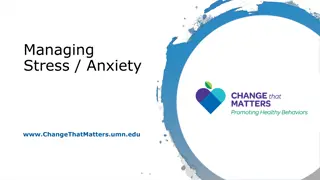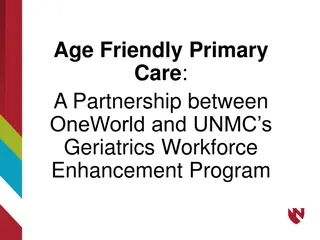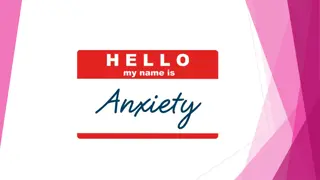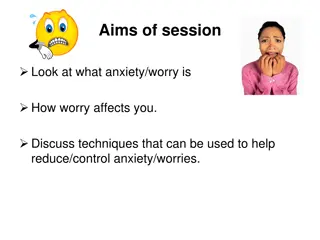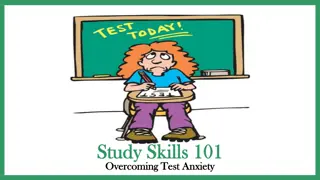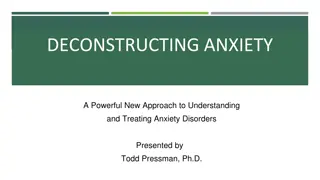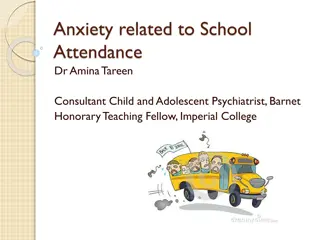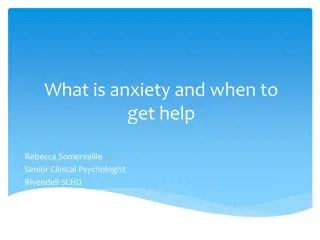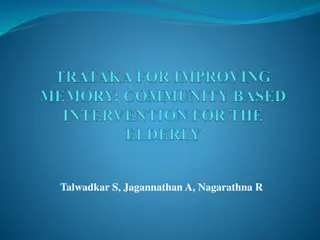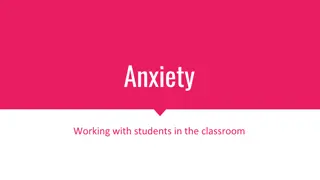Novel Cognitive Target for Treating Irritability and Anxiety in Youth
Research explores Hostile Interpretation Bias as a potential target for treating co-occurring irritability and anxiety in youth. The study investigates why this bias persists in irritable individuals and proposes Interpretation Bias Training as a treatment approach. Computational learning models are utilized to understand face stimuli judgments and learning processes.
Download Presentation

Please find below an Image/Link to download the presentation.
The content on the website is provided AS IS for your information and personal use only. It may not be sold, licensed, or shared on other websites without obtaining consent from the author.If you encounter any issues during the download, it is possible that the publisher has removed the file from their server.
You are allowed to download the files provided on this website for personal or commercial use, subject to the condition that they are used lawfully. All files are the property of their respective owners.
The content on the website is provided AS IS for your information and personal use only. It may not be sold, licensed, or shared on other websites without obtaining consent from the author.
E N D
Presentation Transcript
14 August, 2017 A Novel Cognitive Target for the Treatment of Co-occurring Irritability and Anxiety in Youth Analyse DeSousa1,2, Simona Haller PhD3, Ellen Leibenluft MD3, Melissa Brotman PhD3, Matt Jones PhD4, Joel Stoddard MD1,2 1Pediatric Mental Health Institute, Children s Hospital Colorado; 2School of Medicine, University of Colorado (Anschutz); 3Emotion and Development, NIMH; 4Institute of Cognitive Science, University of Colorado (Boulder)
Irritability Debilitating symptom that spans mental disorders BP, anxiety, DMDD, etc Few evidence based treatments One promising target for treatment development is the Hostile Interpretation Bias
Tendency to judge ambiguous social information as being threatening Hostile Interpretation Bias (HIB) HIB persists in irritable youth, even when they receive feedback that social information is benign1 1. Stoddard, J., et al. (2016).
Tendency to judge ambiguous social information as being threatening Hostile Interpretation Bias (HIB) HIB persists in irritable youth, even when they receive feedback that social information is benign1 Two hypothesis may explain why HIB persists: -Irritable youth may not detect subtle social cues -Irritable youth may be slow to learn benign associations 1. Stoddard, J., et al. (2016).
Fixation (1500-2500 ms) Face (200 ms) Mask (20 ms) Remained until happy or angry response made
Interpretation Bias Training Training Blocks Assess Train x 6 Angry judgments X Happy judgments Assess Baseline balance point Feedback threshold
Computational Learning Model V= ( V) Face Stimuli Judgement H A
Computational Learning Model V= ( V) Parameter Measures Face Stimuli Generalization Judgement H Learning Rate A Reliability
Remember: Prior work suggested two hypothesis may not detect subtle social cues may be slow to learn benign associations Generalization Learning Rate Group Group n=9 DMDD; n=15 HV
Study Population Characteristics M (SD) 48 youth (8-21 yo); %F=41.67 Age 14.1 (3.0) 8 youth were excluded for accuracy <75% IQ 115.3 (11.4) ARI (Irritability) 1.4 (1.8) SCARED (Anxiety) 12.7 (11.3) CDI (Depression) 15.1 (10.0) CONNERS (ADHD)54.5 (15.0)
Data Analysis Mixed effects model: (may not detect subtle social cues) ARI + SCARED = (may be slow to learn benign associations) Adjusting for age, gender, and IQ Subject as random factor
Generalization (): Results We found no significant associations between and any of the clinical variables (p values>0.08) Learning Rate ( ): Significant interactive effect of ARI by SCARED across , (SE)=0.01(0.005), t(27)=2.11, p=0.04 All other associations with were non-significant (p values>0.18)
Generalization (): Results We found no significant associations between and any of the clinical variables (p values>0.08) Learning Rate ( ): Significant interactive effect of ARI by SCARED across , (SE)=0.01(0.005), t(27)=2.11, p=0.04 All other associations with were non-significant (p values>0.18)
Irritability by Anxiety on Learning Rate
Irritable youth may not detect subtle social cues Key Findings Irritable youth may be slow to learn benign associations The significant effect we found was opposite our expectations Post hoc analysis: Quick to learnangryassociations Instead of slow to learn benign associations
Irritable youth may not detect subtle social cues Key Findings Irritable youth may be slow to learn benign associations The significant effect we found was opposite our expectations Post hoc analysis: Quick to learnangryassociations Instead of slow to learn benign associations Limitations Low level irritability in sample Depression and ADHD may be confounds
Irritability and anxiety should be considered together in further development Future Directions Investigate the rapid reinforcement of hostile judgements as a potential training target
References 1. Stoddard, J., Sharif-Askary, B., Harkins, E.A., Frank, H.R., Brotman, M.A., Penton-Voak, I.S., Maoz, K., Bar- Haim, Y., Munafo, M., Pine, D.S., Liebenluft, E. (2016). An open pilot study of training hostile interpretation bias to treat disruptive mood disorder. Journal of Child and Adolescent Psychopharmacology, 26, 49-57. doi: 10.1089/cap.2015.0100
Acknowledgment All participants and their families Our lab team: Joel Stoddard, MD Anne Penner, MD Robert Evans Our Collaborators: Simona Haller, PhD Ellen Leibenluft, MD Melissa Brotman, PhD Matt Jones, PhD PMHI Summer Research Program: Merlin Ariefdjohan, PhD, MPH Emmaly Owens, MA Marisa Deguzman Funding NIMH Intramural Research Program Department of Psychiatry, School of Medicine, University of Colorado Dr. Dominique Martinez, CCTSI, Office of Diversity and Inclusion, University of Colorado Dr. Douglas Novins and Dr. Jennifer Hagman, PMHI, Department of Psychiatry, School of Medicine, University of Colorado
C o r r e l a t i o n o f C l i n i c a l V a r i a b l e s ( r ) A g e 0 . 0 2 0 . 1 7 0 . 0 6 - 0 . 0 3 0 . 1 7 I Q 0 . 0 2 0 . 1 4 - 0 . 0 3 0 . 0 5 - 0 . 1 4 0 . 2 5 A R I 0 . 1 7 0 . 1 4 0 . 4 7 0 . 1 5 0 . 4 8 S C A R E D 0 . 0 6 - 0 . 0 3 0 . 4 7 0 . 1 1 0 . 3 1 C D I - 0 . 0 3 0 . 0 5 0 . 1 5 0 . 1 1 0 . 0 9 0 C O N N E R S 0 . 1 7 - 0 . 1 4 0 . 4 8 0 . 3 1 0 . 0 9 C D I A R I A g e C O N N E R S I Q S C A R E D
Clinical Diagnosis N (%) DMDD 6 (12.5%) ADHD 15 (31.3%) Anxiety 5 (10.4%) Relatives of BD 6 (12.5%) BD 2 (4.2%) HV 14 (12.2%)
